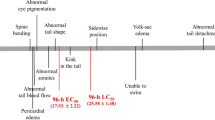Summary
The teratogenic potential of two antifungal triazoles (Triadimefon and Triadimenol) has been investigated in vitro by the rat postimplantation whole embryo culture method. Rat embryos 9.5 d old were cultured for 48 h in rat serum with Triadimefon (12.5–250 μM) or Triadimenol (6.25–125 μM) and then examined. Some embryos exposed to Triadimenol (6.25–125 μM) were cultured for 12 extra hours in control serum to improve their developmental degree and then immunostain cranial nerves and ganglia. The exposure to the highest doses of triazoles only moderately reduced some morphometrical developmental parameters. By contrast, 25–250 μM Triadimefon and 25–125 μM Triadimenol induced specific concentration-related teratogenic effects at the level of first and second branchial arches. After immunostaining, embryos exposed to 12.5–125 μM Triadimenol showed specific cranial nerve and ganglia abnormalities. The possible implication of neural crest cell alterations on triazole-related abnormalities is discussed.
Similar content being viewed by others
References
Altman, J.; Bayer, S. A. Development of the cranial nerve ganglia and related nuclei in the rat. Berlin, Heidelberg, New York: Springer-Verlag; 1982.
Becker, H.; Frei, D.; Sachsse, K. Dose-finding embryotoxicity (including teratogenicity) study with KWG 0519 in the rabbit. RCC Itingen, Switzerland. Unpublished report No. R 3826; 1986.
Bradford, M. M. A rapid and sensitive method for the quantitation of microgram quantities of protein. Anal Biochem. 72:248–274; 1976.
Brown, N. A.; Fabro, S. Quantitation of rat embryonic development in vitro: a morphological scoring system. Teratology 24:65–78; 1981.
Giavini, E.; Broccia, M. L.; Prati, M.; Bellomo, D.; Menegola, E. Effects of ethanol and acetaldehyde on rat embryos developing in vitro. In Vitro Cell. Dev. Biol. 28A:205–210; 1992.
Gofflot, F.; Van Maele-Fabry, G.; Picard, J. J. Cranial nerves and ganglia are altered after in vitro treatment of mouse embryos with valproic acid (VPA) and 4-en-VPA. Dev. Brain Res. 93:62–69; 1996.
Kimmel, C. B.; Schilling, T. F.; Hatta, K. Patterning of body segments of the zebrafish embryo. Curr. Topics Dev. Biol. 25:77–110; 1991.
Korte, R.; Osterburg, I. Embryotoxicity of KWG 0519 in rabbits. Unpublished report No. R 1901. Reprotox GmbH, Munster, FRG; 1980.
Kuratani, S.; Aizawa, S. Patterning of the cranial nerves in the chick embryo is dependent on cranial mesoderm and rhombomeric metamerism. Dev. Growth Differ. 37:717–731; 1995.
Labarca, C.; Paigen, K. A simple, rapid and sensitive DNA assay procedure. Anal. Biochem. 102:344–352; 1980.
Le Douarin, N. M. The neural crest. Cambridge: Cambridge: Cambridge University Press; 1982.
Lee, Y. M.; Osumi-Yamashita, N., et al. Retinoic acid stage-dependently alters the migration pattern and identity of hindbrain neural crest cells. Development 121:825–837; 1995.
Machemer, L. Evaluation of embryotoxic and teratogenic effects on rabbits following oral administration. Unpublished report No. 6297. Bayer AG, Wuppertal-Elberfeld, FRG; 1976a.
Machemer, L. Evaluation of embryotoxic and teratogenic effects on rats following oral administration. Unpublished report No. 6294. Bayer AG, Wuppertal-Elberfeld, FRG; 1976b.
Machemer, L. Evaluation for embryotoxic and teratogenic effects on orally dosed rats. Unpublished report No. 7038. Bayer AG, Wuppertal-Elberfeld, FRG; 1977.
Mark, M.; Lufkin, T.; Vonesch, J. L., et al. Two rhombomeres are altered in Hoxa-1 mutant mice. Development 119:319–338; 1993.
Mulder, G. B.; Manley, N.; Maggio-Price, L. Retinoic acid-induced thymic abnormalities in the mouse are associated with altered pharyngeal morphology, thymocite maturation defects, and altered expression of Hoxa3 and Pax1. Teratology 58:263–275; 1998.
New, D. A. T. Whole embryo culture and the study of mammalian embryos during organogenesis. Biol. Rev. 53:81–122; 1978.
Noden, D. M. Interactions and fate of avian craniofacial mesenchyme. Development (Suppl.) 103:121–140; 1988.
Tiboni, G. T. Second branchial arch anomalies induced by fluconazole, a bistriazole antifungal agent, in cultured mouse embryos. Res. Commun. Chem. Pathol. Pharmacol. 79:381–384; 1993.
Trainor, P. A.; Tam, P. P. L. Cranial paraxial mesoderm and neural crest cells of the mouse embryo: co-distribution in the craniofacial mesenchyme but distinct segregation in branchial arches. Development 121:2569–2582; 1995.
Unger, T. M.; Van Goethem, D.; Shellenberger, T. E. A teratological evaluation of Bayleton in mated female rats. Unpublished report No. 324. Midwest Research Institute, Mobay Chemical Corporation, Agricultural Chemical Division, Bayer AG; 1982.
Van Maele-Fabry, G.; Gofflot, F.; Clotman, F.; Picard, J. J. Alterations of mouse embryonic branchial nerves and ganglia induced by ethanol. Neurotoxicol. Teratol. 4:497–506; 1995.
Van Maele-Fabry, G.; Gofflot, F.; Picard, J. J. Defects in the development of branchial nerves and ganglia induced by in vitro exposure of mouse embryos to mercuric chloride. Tetratology 53:10–20; 1996.
Williams, J. A.; Horton, C.; Mann, F. M.; Maden, M.; Brown, N. A. Alteration of endogenous retinoid status as a potential mechanism of triazole teratogenicity. Teratology 53:21A; 1996.
Zucker, R. M.; Elstein, K. H.; Shuey, D. L.; Ebron-McCoy, M.; Rogers, J. M. Utility of fluorescence microscopy in embryonic/fetal topographical analysis. Teratology 51:430–434; 1995.
Author information
Authors and Affiliations
Corresponding author
Rights and permissions
About this article
Cite this article
Menegola, E., Broccia, M.L., Di Renzo, F. et al. In vitro teratogenic potential of two antifungal triazoles: Triadimefon and triadimenol. In Vitro Cell.Dev.Biol.-Animal 36, 88–95 (2000). https://doi.org/10.1290/1071-2690(2000)036<0088:IVTPOT>2.0.CO;2
Received:
Accepted:
Issue Date:
DOI: https://doi.org/10.1290/1071-2690(2000)036<0088:IVTPOT>2.0.CO;2




